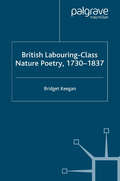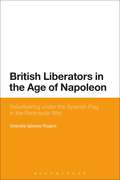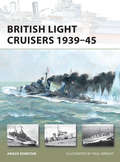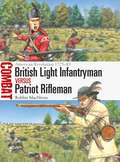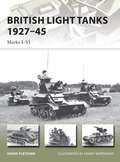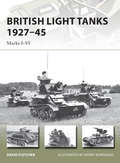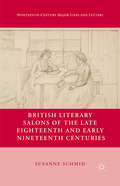- Table View
- List View
The British Labour Party and the Wider World: Domestic Politics, Internationalism and Foreign Policy (International Library of Political Studies)
by Paul Corthorn Jonathan DavisThe legacy of Blair and the invasions of Iraq and Afghanistan continue to loom large for the Labour Party, whether in opposition or in government, giving rise to fierce debates over Labour's attitude and posture towards the wider world. This book considers the idea of Labour's international identity, examining how world events and Labour's response to them have helped to shape ideology, political culture and domestic agendas from the 1920s until the Iraq War. It provides a fascinating and original exploration of Labour both on the world stage and at home - from the influence of the Soviet Union on political thought in the interwar years to the international student revolts of the 1960s, and from media in the 1990s to Kosovo and New Labour Interventionism.This is essential reading for scholars of modern British politics, as well as anyone interested in the motivations and influences behind the Labour Party's actions on the world stage.
British Labour Seeks a Foreign Policy, 1900-1940
by Henry WinklerSince World War II, the British Labour Party has played a central role in dealing with complex international issues. Achieving real power in parliament for the first time, Labour governments have acted responsibly, and are usually in accord with the views of a substantial majority of the British people. Such was not always the case. In British Labour Seeks a Foreign Policy, 1900-1940, Henry R. Winkler synthesizes twenty years' study of the subject to offer the first full-scale treatment of the Labour Party's evolution in foreign affairs.The Labour Party came into existence at the beginning of the twentieth century to deal with the domestic problems of the working class, and it showed relatively little interest in foreign policy issues. In the aftermath of World War I, however, small groups of moderates made the case against the bitter rejection of the Versailles Treaty by many in the Labour Party and the trade union movement. Most of these argued that the League of Nations could be used to remedy some of the deficiencies of the settlement and that such a League must have the sanction of force if it was to be effective.During the 1930s, the failures of the League--in the Far East, Abyssinia, Spain, and Central Europe--compelled some of its advocates to conclude that, League or no League, the threat from Nazi Germany mandated support for a program of preparedness and rearmament even under the aegis of a hated National Government. The result, by 1937, was the final formal abandonment of many of the radical illusions of the twenties and thirties, as Labour reluctantly but formally assumed a posture that enabled it to share in the governance of wartime Britain and to take a key role in dealing with the international issues that emerged in the aftermath of the Second World War.This volume contains valuable lessons on the responsibilities of political parties as well as the pros and cons of specific policies. It is essential reading for understanding Britain's later stands as its leaders tried to adjust to Britain's diminished power in the post-World War II world.
British Labour Seeks a Foreign Policy, 1900-1940
by Henry R. WinklerSince World War II, the British Labour Party has played a central role in dealing with complex international issues. Achieving real power in parliament for the first time, Labour governments have acted responsibly, and are usually in accord with the views of a substantial majority of the British people. Such was not always the case. In British Labour Seeks a Foreign Policy, 1900-1940, Henry R. Winkler synthesizes twenty years' study of the subject to offer the first full-scale treatment of the Labour Party's evolution in foreign affairs.The Labour Party came into existence at the beginning of the twentieth century to deal with the domestic problems of the working class, and it showed relatively little interest in foreign policy issues. In the aftermath of World War I, however, small groups of moderates made the case against the bitter rejection of the Versailles Treaty by many in the Labour Party and the trade union movement. Most of these argued that the League of Nations could be used to remedy some of the deficiencies of the settlement and that such a League must have the sanction of force if it was to be effective.During the 1930s, the failures of the League--in the Far East, Abyssinia, Spain, and Central Europe--compelled some of its advocates to conclude that, League or no League, the threat from Nazi Germany mandated support for a program of preparedness and rearmament even under the aegis of a hated National Government. The result, by 1937, was the final formal abandonment of many of the radical illusions of the twenties and thirties, as Labour reluctantly but formally assumed a posture that enabled it to share in the governance of wartime Britain and to take a key role in dealing with the international issues that emerged in the aftermath of the Second World War.This volume contains valuable lessons on the responsibilities of political parties as well as the pros and cons of specific policies. It is essential reading for understanding Britain's later stands as its leaders tried to adjust to Britain's diminished power in the post-World War II world.
British Labouring-Class Nature Poetry, 1730-1837
by B. KeeganThis study shows how poets worked within and against the available forms of nature writing to challenge their place within physical, political, and cultural landscapes. Looking at the treatment of different ecosystems, it argues that writing about the environment allowed labouring-class poets to explore important social and aesthetic questions.
The British left and the defence economy: Rockets, guns and kidney machines, 1970–83
by Keith Mc LoughlinForty years before COVID-19, socialists in Britain campaigned for workers to have the right to make ‘socially useful’ products, from hospital equipment to sustain the NHS to affordable heating systems for the impoverished elderly. This movement held one thing responsible above all else for the nation’s problems: the burden of defence spending. In the middle of the Cold War, the left put a direct challenge to the defence industry, the Labour government and trade unions. The response it received revealed much about a military-industrial state that prioritised the making and exporting of arms for political favour and profit.Looking at peace activism from the early 1970s to Labour’s landslide defeat in the 1983 general election, this book examines the conflict over the cost of Britain’s commitment to the Cold War and asserts that the wider left presented a comprehensive and implementable alternative to the stark choice between making weapons and joining the dole queue.
The British left and the defence economy: Rockets, guns and kidney machines, 1970–83
by Keith Mc LoughlinForty years before COVID-19, socialists in Britain campaigned for workers to have the right to make ‘socially useful’ products, from hospital equipment to sustain the NHS to affordable heating systems for the impoverished elderly. This movement held one thing responsible above all else for the nation’s problems: the burden of defence spending. In the middle of the Cold War, the left put a direct challenge to the defence industry, the Labour government and trade unions. The response it received revealed much about a military-industrial state that prioritised the making and exporting of arms for political favour and profit.Looking at peace activism from the early 1970s to Labour’s landslide defeat in the 1983 general election, this book examines the conflict over the cost of Britain’s commitment to the Cold War and asserts that the wider left presented a comprehensive and implementable alternative to the stark choice between making weapons and joining the dole queue.
The British left and Zionism: History of a divorce
by Paul KelemenThe changes and divisions on the British Left over the Israel-Palestine conflict forms the central theme of this archive based study.
British Lend-Lease Warships 1940–45: The Royal Navy's American-built destroyers and frigates (New Vanguard #330)
by Angus KonstamAn illustrated history of the American-built destroyers and frigates supplied to the Royal Navy under Lend-Lease, which played a crucial role in Britain's war in the Atlantic.As U-boat attacks on Britain's vital sea lanes increased in ferocity, and Royal Navy warship losses mounted, the United States passed the Lend-Lease Act, the cornerstone of America's wartime role as armourer to the Allies. Naval historian Angus Konstam here offers an account of the Royal Navy's Lend-Lease destroyers and escorts. The first batch were 50 World War I-era 'four-stacker' destroyers, in a deal sealed by the transfer of several global British bases to the USA. These warships were immediately recrewed, refitted and pressed into service in the Battle of the Atlantic. These ageing destroyers were followed by over a hundred more Lend-Lease warships, many of which were built especially for British service in American shipyards. Their arrival helped tip the balance in the hard-fought war against the U-boats, while others were used to fulfil other crucial wartime missions. With detailed ship profiles of the major classes, a cutaway of HMS Campbeltown (of Saint-Nazaire raid fame) as it appeared in 1941, and superb battlescene artwork, this is a comprehensive look at a crucial aspect of the Battle of the Atlantic.
British Lend-Lease Warships 1940–45: The Royal Navy's American-built destroyers and frigates (New Vanguard #330)
by Angus KonstamAn illustrated history of the American-built destroyers and frigates supplied to the Royal Navy under Lend-Lease, which played a crucial role in Britain's war in the Atlantic.As U-boat attacks on Britain's vital sea lanes increased in ferocity, and Royal Navy warship losses mounted, the United States passed the Lend-Lease Act, the cornerstone of America's wartime role as armourer to the Allies. Naval historian Angus Konstam here offers an account of the Royal Navy's Lend-Lease destroyers and escorts. The first batch were 50 World War I-era 'four-stacker' destroyers, in a deal sealed by the transfer of several global British bases to the USA. These warships were immediately recrewed, refitted and pressed into service in the Battle of the Atlantic. These ageing destroyers were followed by over a hundred more Lend-Lease warships, many of which were built especially for British service in American shipyards. Their arrival helped tip the balance in the hard-fought war against the U-boats, while others were used to fulfil other crucial wartime missions. With detailed ship profiles of the major classes, a cutaway of HMS Campbeltown (of Saint-Nazaire raid fame) as it appeared in 1941, and superb battlescene artwork, this is a comprehensive look at a crucial aspect of the Battle of the Atlantic.
British Leyland Motor Corporation 1968-2005: The Story from Inside
by Mike Carver Nick Seale Anne YoungsonBritish Leyland Motor Corporation, formed in the wake of the post-war manufacturing boom, brought together almost all the British-owned car and commercial vehicle companies that then existed. At the head of the sixth largest car manufacturer in the world, its management confidently expected to give the United Kingdom a leading place in the global motor industry. Their catastrophic failure was one of the biggest and most disappointing disasters in British industrial history. From their unique insider perspective, three former employees of the brand reveal how and why, despite producing profitable marques such as Jaguar, Rover and Land Rover, as well as the iconic best-selling Mini, British Leyland came to its sad end …
British Liberalism and the United States: Political and Social Thought in the Late Victorian Age
by Murney GerlachWhile there are many works on British liberalism, this is the first to deal substantially with the transatlantic and international content of liberalism. Gerlach considers the transatlantic thought of prominent contemporary figures such as William Gladstone, John Morley, William Harcourt and Andrew Carnegie. A fascinating account that paves the way for the political and social rapprochement of the twentieth century.
British Liberators in the Age of Napoleon: Volunteering under the Spanish Flag in the Peninsular War
by Graciela Iglesias RogersThis book unveils the role of a hitherto unrecognized group of men who, long before the International Brigades made its name in the Spanish Civil War, also found reasons to fight under the Spanish flag. Their enemy was not fascism, but what could be at times an equally overbearing ideology: Napoleon's imperialism.Although small in number, British volunteers played a surprisingly influential role in the conduct of war operations, in politics, gender and social equality, in cultural life both in Britain and Spain and even in relation to emancipation movements in Latin America. Some became prisoners of war while a few served with guerrilla forces.Many of the works published about the Peninsular War in the last two decades have adopted an Anglocentric narrative, writing the Spanish forces out of victories, or have tended to present the war, not as much won by the allies, but lost by the French. This book takes a radically different approach by drawing on previously untapped archival sources to argue that victory was the outcome of a truly transnational effort. >
British Liberators in the Age of Napoleon: Volunteering under the Spanish Flag in the Peninsular War
by Graciela Iglesias RogersThis book unveils the role of a hitherto unrecognized group of men who, long before the International Brigades made its name in the Spanish Civil War, also found reasons to fight under the Spanish flag. Their enemy was not fascism, but what could be at times an equally overbearing ideology: Napoleon's imperialism.Although small in number, British volunteers played a surprisingly influential role in the conduct of war operations, in politics, gender and social equality, in cultural life both in Britain and Spain and even in relation to emancipation movements in Latin America. Some became prisoners of war while a few served with guerrilla forces.Many of the works published about the Peninsular War in the last two decades have adopted an Anglocentric narrative, writing the Spanish forces out of victories, or have tended to present the war, not as much won by the allies, but lost by the French. This book takes a radically different approach by drawing on previously untapped archival sources to argue that victory was the outcome of a truly transnational effort.
British Light Cruisers 1939–45 (New Vanguard)
by Paul Wright Angus KonstamThe light cruiser was a natural development of the sailing frigate – a fast multi-purpose warship that could patrol the sea lanes, protect convoys and scout for enemy battle fleets. By the inter-war period the need for this type of ship was even more important, given the increasing need for protection from aircraft, and the need to screen the fleet from submarines or destroyers. Wartime experience had shown that the British light cruiser was one of the most versatile types of ship in the Royal Navy, able to protect other warships, bombard enemy shores, guard life-saving convoys and intercept and destroy enemy warships. These were truly the workhorses of the wartime Royal Navy. While the battleships and carriers grabbed the headlines, these sleek, elegant warships quietly got on with the job of securing control of the seas.
British Light Cruisers 1939–45 (New Vanguard #194)
by Paul Wright Angus KonstamThe light cruiser was a natural development of the sailing frigate – a fast multi-purpose warship that could patrol the sea lanes, protect convoys and scout for enemy battle fleets. By the inter-war period the need for this type of ship was even more important, given the increasing need for protection from aircraft, and the need to screen the fleet from submarines or destroyers. Wartime experience had shown that the British light cruiser was one of the most versatile types of ship in the Royal Navy, able to protect other warships, bombard enemy shores, guard life-saving convoys and intercept and destroy enemy warships. These were truly the workhorses of the wartime Royal Navy. While the battleships and carriers grabbed the headlines, these sleek, elegant warships quietly got on with the job of securing control of the seas.
British Light Infantry in the American Revolution (Elite)
by Robbie MacNivenDuring the Seven Years' War (1755–63), a number of independent light-infantry outfits served under British command and dedicated light companies were added to the British Army's regular infantry battalions. The light companies were disbanded after the war but the prominent role played by light infantry was not forgotten, and in 1771–72 light-infantry companies were reinstated in every regiment in the British Isles. Although William Howe formed a training camp at Salisbury in 1774 specifically to practise light-infantry doctrine, the outbreak of the American Revolution in 1775 found the British Army wanting, and the light companies were no different. After evacuating Boston in March 1776, Howe began to remodel and drill his army at Halifax, standardizing lighter uniform and emphasizing more open-order tactics. He also brigaded his light companies together into composite battalions, which went on to fight in almost every major engagement during the American Revolution. They spearheaded British assaults, using night-time surprise and relying upon the bayonet in engagements such as Paoli and Old Tappan. They also matched their regular and irregular opponents in bush-fighting, and at times fought in far-flung detachments alongside Native American and Loyalist allies on the frontier. Featuring specially commissioned full-colour artwork, this book offers a comprehensive guide to the formation, uniform, equipment, doctrines and tactics of these elite light infantry companies and battalions, and considers how, over the course of the war they developed a fearsome reputation, and exemplified the psychological characteristics exhibited by crack military units across history.
British Light Infantry in the American Revolution (Elite #237)
by Robbie MacNivenDuring the Seven Years' War (1755–63), a number of independent light-infantry outfits served under British command and dedicated light companies were added to the British Army's regular infantry battalions. The light companies were disbanded after the war but the prominent role played by light infantry was not forgotten, and in 1771–72 light-infantry companies were reinstated in every regiment in the British Isles. Although William Howe formed a training camp at Salisbury in 1774 specifically to practise light-infantry doctrine, the outbreak of the American Revolution in 1775 found the British Army wanting, and the light companies were no different. After evacuating Boston in March 1776, Howe began to remodel and drill his army at Halifax, standardizing lighter uniform and emphasizing more open-order tactics. He also brigaded his light companies together into composite battalions, which went on to fight in almost every major engagement during the American Revolution. They spearheaded British assaults, using night-time surprise and relying upon the bayonet in engagements such as Paoli and Old Tappan. They also matched their regular and irregular opponents in bush-fighting, and at times fought in far-flung detachments alongside Native American and Loyalist allies on the frontier. Featuring specially commissioned full-colour artwork, this book offers a comprehensive guide to the formation, uniform, equipment, doctrines and tactics of these elite light infantry companies and battalions, and considers how, over the course of the war they developed a fearsome reputation, and exemplified the psychological characteristics exhibited by crack military units across history.
British Light Infantry & Rifle Tactics of the Napoleonic Wars (Elite)
by Philip HaythornthwaiteIn an age when infantry units manoeuvred and fought in rigid blocks, the idea of encouraging initiative and allowing a unit to 'skirmish' was regarded as revolutionary and fell out of favour in the years following the French-Indian and American Revolutionary wars. It was revived by far-sighted British and foreign-mercenary officers, who observed the way in which French Revolutionary armies deployed skirmishers to prepare the way for their assault columns.Offering a detailed analysis of the tactics, this book is studded with period 'battle descriptions' quoted from eye-witness accounts, creating a comprehensive guide to the Light and Rifles units of Wellington's Light Division. As the result of the first tentative experiments in skirmishing the units achieved an unsurpassed peak of efficiency – they marched faster, were versatile in any sort of tactical situation and could shoot more accurately than either friend or foe. No other national army, either allied or enemy, achieved these standards.
British Light Infantry & Rifle Tactics of the Napoleonic Wars (Elite)
by Adam Hook Philip HaythornthwaiteIn an age when infantry units manoeuvred and fought in rigid blocks, the idea of encouraging initiative and allowing a unit to 'skirmish' was regarded as revolutionary and fell out of favour in the years following the French-Indian and American Revolutionary wars. It was revived by far-sighted British and foreign-mercenary officers, who observed the way in which French Revolutionary armies deployed skirmishers to prepare the way for their assault columns.Offering a detailed analysis of the tactics, this book is studded with period 'battle descriptions' quoted from eye-witness accounts, creating a comprehensive guide to the Light and Rifles units of Wellington's Light Division. As the result of the first tentative experiments in skirmishing the units achieved an unsurpassed peak of efficiency – they marched faster, were versatile in any sort of tactical situation and could shoot more accurately than either friend or foe. No other national army, either allied or enemy, achieved these standards.
British Light Infantryman vs Patriot Rifleman: American Revolution 1775–83 (Combat)
by Robbie MacNivenFully illustrated, this book assesses the origins, equipment, and fighting styles of the irregular warfare specialists fighting on both sides during the American Revolutionary War.Amid North America's often forested, broken, or rugged terrain, 18th-century armies came to rely on soldiers capable of fighting individually or in small groups. During the American Revolutionary War, rifle-armed companies were incorporated into the newly created Continental Army, while Patriot militiamen and partisans also made use of rifled weapons. Facing them were the British Army's light infantrymen; among the most experienced regular soldiers fighting for the Crown, they were joined by Loyalist units able to operate in dispersed formations and German hired troops skilled in open-order fighting, including the rifle-armed Jäger.The strengths and limitations of both sides' open-order specialists are evaluated in this book, with particular focus upon three revealing battles: Harlem Heights (September 16, 1776), where the Patriots took heart from being able to hold their own in an escalating clash with Crown light forces; Freeman's Farm (September 19, 1777), where British light infantry engaged Patriot riflemen in notably rough terrain; and Hanging Rock (August 6, 1780), where Patriot riflemen and partisans attacked a Loyalist encampment, including Provincial Corps light infantry. Specially commissioned artwork, archive illustrations, and newly drawn mapping complement the authoritative text.
British Light Infantryman vs Patriot Rifleman: American Revolution 1775–83 (Combat)
by Robbie MacNivenFully illustrated, this book assesses the origins, equipment, and fighting styles of the irregular warfare specialists fighting on both sides during the American Revolutionary War.Amid North America's often forested, broken, or rugged terrain, 18th-century armies came to rely on soldiers capable of fighting individually or in small groups. During the American Revolutionary War, rifle-armed companies were incorporated into the newly created Continental Army, while Patriot militiamen and partisans also made use of rifled weapons. Facing them were the British Army's light infantrymen; among the most experienced regular soldiers fighting for the Crown, they were joined by Loyalist units able to operate in dispersed formations and German hired troops skilled in open-order fighting, including the rifle-armed Jäger.The strengths and limitations of both sides' open-order specialists are evaluated in this book, with particular focus upon three revealing battles: Harlem Heights (September 16, 1776), where the Patriots took heart from being able to hold their own in an escalating clash with Crown light forces; Freeman's Farm (September 19, 1777), where British light infantry engaged Patriot riflemen in notably rough terrain; and Hanging Rock (August 6, 1780), where Patriot riflemen and partisans attacked a Loyalist encampment, including Provincial Corps light infantry. Specially commissioned artwork, archive illustrations, and newly drawn mapping complement the authoritative text.
British Light Tanks 1927–45: Marks I–VI (New Vanguard)
by Henry Morshead David FletcherThis is the definitive study of British light tanks of the Second World War. The author draws upon a vast and comprehensive body of archival information and research to explore their technical characteristics and combat performance. The title focuses largely on the very widely used Mark VI, but also covers all the variants that preceded it. The type was truly ubiquitous, equipping the British Army in France, the Western Desert regions, Norway, Sumatra, Persia and India. This book chronicles various experiments and improvisations carried out on the design of these tanks. It ends with coverage of the final model, the Mark VIC, and details of the experimental Lloyd airborne light tank of 1942, which has a number of features in common with the better-known Vickers-Armstrongs designs. Augmented by original photographs and technical drawings, this title is essential for anybody interested in the development of British armoured vehicles.
British Light Tanks 1927–45: Marks I–VI (New Vanguard)
by Henry Morshead David FletcherThis is the definitive study of British light tanks of the Second World War. The author draws upon a vast and comprehensive body of archival information and research to explore their technical characteristics and combat performance. The title focuses largely on the very widely used Mark VI, but also covers all the variants that preceded it. The type was truly ubiquitous, equipping the British Army in France, the Western Desert regions, Norway, Sumatra, Persia and India. This book chronicles various experiments and improvisations carried out on the design of these tanks. It ends with coverage of the final model, the Mark VIC, and details of the experimental Lloyd airborne light tank of 1942, which has a number of features in common with the better-known Vickers-Armstrongs designs. Augmented by original photographs and technical drawings, this title is essential for anybody interested in the development of British armoured vehicles.
British Lions and Mexican Eagles: Business, Politics, and Empire in the Career of Weetman Pearson in Mexico, 1889–1919
by Paul GarnerBetween 1889 and 1919, Weetman Pearson became one of the world's most important engineering contractors, a pioneer in the international oil industry, and one of Britain's wealthiest men. At the center of his global business empire were his interests in Mexico. While Pearson's extraordinary success in Mexico took place within the context of unprecedented levels of British trade with and investment in Latin America, Garner argues that Pearson should be understood less as an agent of British imperialism than as an agent of Porfirian state building and modernization. Pearson was able to secure contracts for some of nineteenth-century Mexico's most important public works projects in large part because of his reliability, his empathy with the developmentalist project of Mexican President Porfirio Díaz, and his assiduous cultivation of a clientelist network within the Mexican political elite. His success thus provides an opportunity to reappraise the role played by overseas interests in the national development of Mexico.
British Literary Salons of the Late Eighteenth and Early Nineteenth Centuries (Nineteenth-Century Major Lives and Letters)
by S. SchmidBritish salons, with guests such as Byron, Moore, and Thackeray, were veritable hothouses of political and cultural agitation. Using a number of sources - diaries, letters, silver-fork novels, satires, travel writing, Keepsakes, and imaginary conversations - Schmid paints a vivid picture of the British salon between the 1780s and the 1840s.


